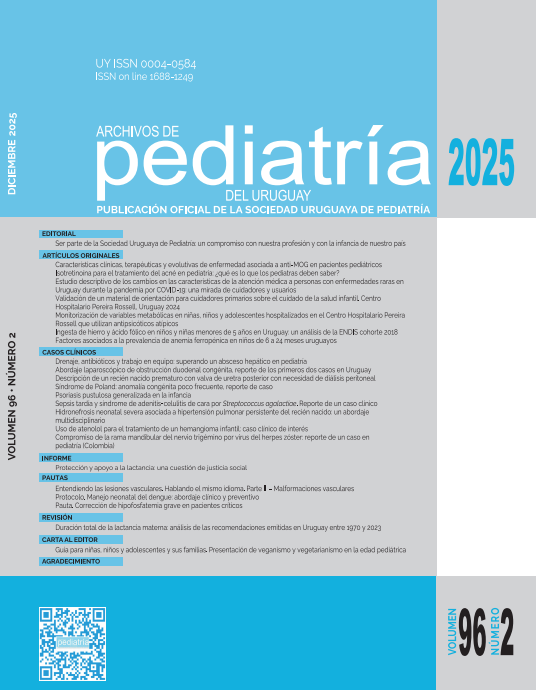Abstract
Objectives: estimate the intake of iron and folic acid and their adequacy to nutritional requirements in children aged 6 to 59 months in Uruguay.
Methodology: we recorded the food intake of a sample of 555 children. We used the PC-Side and Evindi software to obtain the energy and nutrient intake.
Results: 16% of children under 5 years old and 30% of children under 2 years old do not consume the necessary amount of iron. Consumption was lower in households with lower income levels and in those at risk of malnutrition or malnutrition.
5% of children under 5 years old do not meet their folic acid requirements, rising to 13.2% in children under 2 years of age, 11% in households with lower income levels, and 15% in children at risk of malnutrition or suffering from malnutrition.
It was estimated that the fortification of wheat flour with iron and folic acid (Law 18.071) covers 39% of the iron requirement and the entire folic acid requirement in children aged 6 to 59 months.
Conclusions: iron and folic acid deficiency primarily affects children under 2 years of age, those with poor nutritional status, and those from lower socioeconomic strata. Although the food typess included in Law 18.071 contribute to meeting iron and folic acid needs, their contribution is not sufficient, making it important to strengthen other public health measures.
References
Martínez N, Núñez S, Garibotto G. Encuesta de nutrición, desarrollo infantil y salud. Primeros resultados de la Encuesta de Nutrición, Desarrollo Infantil y Salud cohorte 2018. Montevideo: MIDES, MSP, MEC, INAU, INE, CEIP, 2020. Disponible en: https://www.gub.uy/ministerio-desarrollo-social/endis. (Consulta: 30 mayo 2021).
Ley Nº 18.071. Prevención de anemia ferropénica y malformaciones neurales. Fortificación de alimentos con hierro y ácido fólico. Montevideo, 20 de diciembre de 2006. Montevideo: IMPO, 2006. Disponible en: https://impo.com.uy/bases/leyes/18071-2006/2. (Consulta: 30 mayo 2021).
Allen L, de Benoist B, Dary O, Hurrell R, eds. Guías para la fortificación de alimentos con micronutrientes. Ginebra: OMS, FAO, 2017. Disponible en: https://iris.who.int/handle/10665/255541. (Consulta: 30 mayo 2021).
World Health Organization. WHO guideline on use of ferritin concentrations to assess iron status in individuals and populations. Geneva: WHO, 2020. Disponible en: https://www.who.int/publications/i/item/9789240000124. (Consulta: 30 mayo 2021).
Carrero A, Ceriani F, de León C, Girona A. Encuesta nacional de lactancia, prácticas de alimentación y anemia en menores de 24 meses usuarios del Sistema Nacional Integrado de Salud 2020. Montevideo: MSP, 2020. Disponible en: https://bibliotecaunicef.uy/documentos/227_Encuesta_lactancia_alimentacion_anemia_UY2020.pdf. (Consulta: 30 mayo 2021).
Uruguay. Ministerio de Salud Pública. Guía de recomendaciones para la prevención y el tratamiento de la deficiencia de hierro en mujeres en edad fértil, embarazadas y en lactancia, niños menores de 2 años y adolescentes. Montevideo: MSP, 2024.
Centeno E, Pachón H, Guetterman H, Finkelstein J. Fortification of wheat and maize flour with folic acid for population health outcomes. Cochrane Database Syst Rev 2019; 7(7):CD012150. doi: 10.1002/14651858.CD012150.pub2.
Russo M, Elichalt M, Vázquez D, Suburú G, Tihista H, Godiño M. Fortificación de harina de trigo con ácido fólico y hierro en Uruguay: implicancias en la nutrición. Rev Chil Nutr 2014; 41(4):399-403. doi: 10.4067/S0717-75182014000400008.
Uruguay. Ministerio de Salud Pública. Ministerio de Educación Y Cultura. Ministerio de Desarrollo Social. Instituto del Niño y Adolescente del Uruguay. Consejo de Educación Inicial y Primaria. Instituto Nacional de Estadística. Principales resultados del análisis de la encuesta de estimación de la ingesta alimentaria en niños de 6 meses a 4 años. ENDIS 2018: mejores datos, mejor alimentación. Montevideo: MIDES, 2021 Disponible en: https://www.gub.uy/ministerio-desarrollo-social/comunicacion/publicaciones/principales-resultados-del-analisis-encuesta-estimacion-ingesta. (Consulta: 15 junio 2021).
Universidad de Antioquía. Software de evaluación de la ingesta dietética Evindi v5. Medellín: UdeA, 2020. Disponible en: https://www.udea.edu.co/wps/portal/udea/web/inicio/extension/portafoliotecnologico/articulos/Software_de_Evaluacion_de_ingesta. (Consulta: 15 junio 2021).
Nusser S, Carriquiry A, Dodd K, Fuller W, Jensen H. User's guide to C-SIDE, a software for intake distribution estimation. Version 1.0. Dietary Assessment Research Series Report 8. Iowa: Iowa State University, Center for Agricultural and Rural Development, 1996. Disponible en: https://www.researchgate.net/publication/5104284. (Consulta: 15 junio 2021).
Institute of Medicine. Food and Nutrition Board. Dietary reference intakes: applications in dietary assessment. Washington, DC: National Academy Press, 2000.
Uruguay. Ministerio de Salud Pública, Ministerio de Desarrollo Social, Uruguay Crece Contigo. Evaluación del crecimiento del niño y la niña desde el nacimiento hasta los 5 años de edad. Montevideo: MSP, 2020.

This work is licensed under a Creative Commons Attribution 4.0 International License.
Copyright (c) 2025 Archives of Pediatrics of Uruguay


